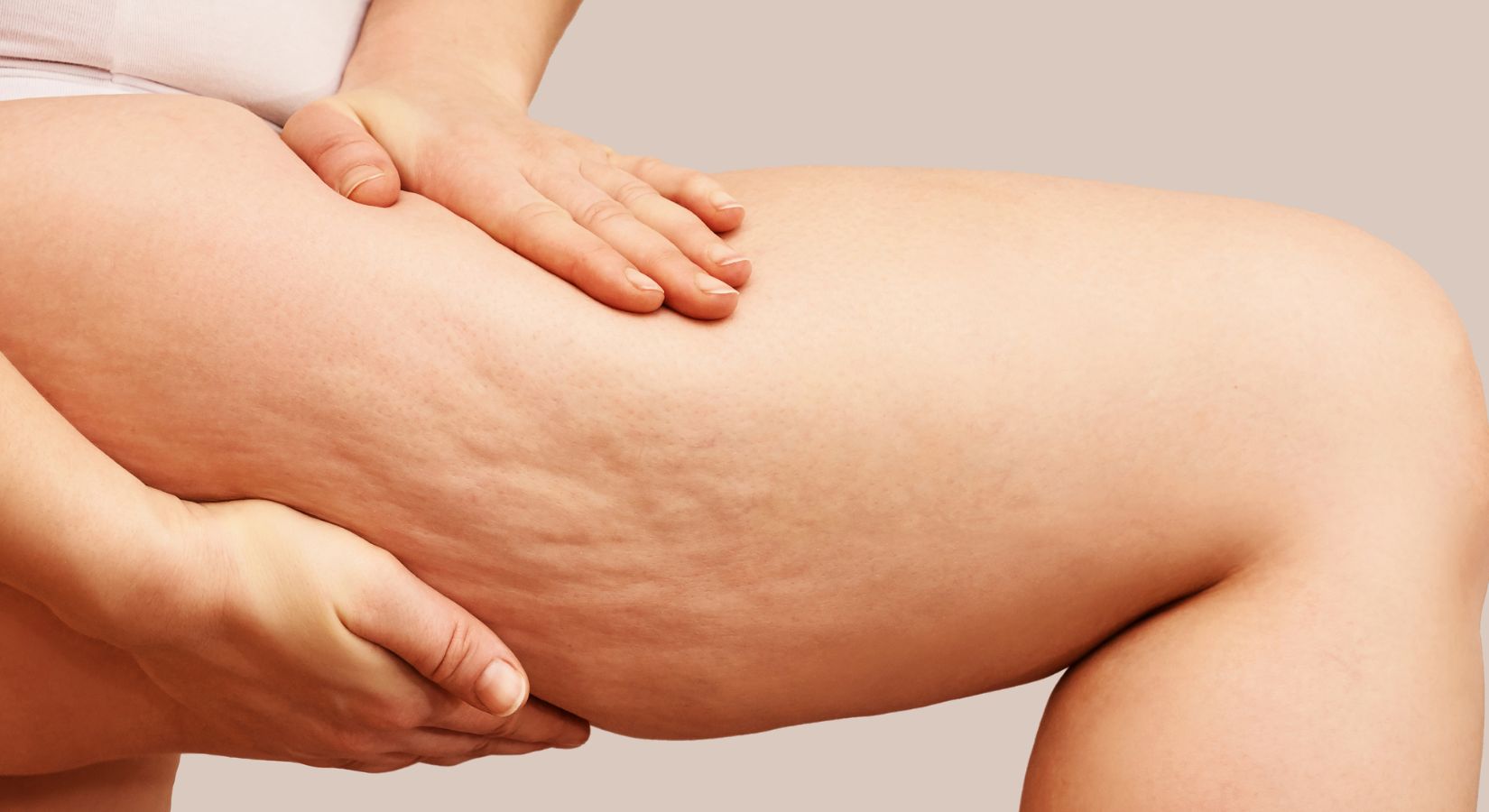Red light therapy has been a popular treatment in recent years as it has become more and more accessible to people who want to take control of their health and beauty regime.
Does red light therapy help with cellulite, though? The answer may surprise you…
Let’s look at some evidence of how this process works, shall we?
- What is Red Light Therapy (RLT)?
- How Does Red Light Therapy Work?
- What is Cellulite?
- What Causes Cellulite?
- How Does Red Light Therapy Treat Cellulite?
- What Equipment Do I Need For RLT Treatment At Home?
- Does Red Light Therapy Work?
- What Are the Dangers of Using RLT At Home?
- Summary: Red Light Therapy Can Significantly Reduce the Appearance and Formation of Cellulite
What is Red Light Therapy (RLT)?
To get to the bottom of what red light therapy is, it helps to understand just how the process works. RLT treatment uses a process called biostimulation. A beam of light is used to activate specific biochemical processes within skin cells that promote cell metabolism and repair.
This increases their natural resistance against infections, slows down aging, and helps treat various dermatological disorders like cellulite, acne vulgaris, psoriasis, atopic dermatitis, etc.
So what is red light therapy? It’s actually pretty cool how it works! It’s proven to help with everything from muscle recovery after exercise to even as an anti-aging treatment.
[Read: What is Red Light Therapy?]
How Does Red Light Therapy Work?
Before you begin your treatments, it’s helpful to know exactly how red light therapy works. Like many aesthetic treatments, RLT works by improving blood flow to areas of your body that may be more prone to cellulite and other skin-related issues.

When we have ample blood flow to our bodies (thanks, in part, to regular exercise and dietary choices), our systems—including our cells—can function better.
This improved circulation also means an improvement in hydration and oxygenation; these are both extremely important aspects of treating cellulite as well as other forms of fat that may clog our skin or appear in clusters on certain parts of our bodies.
As mentioned, red light therapy works by encouraging blood flow to your skin. This leads to an improvement in hydration and oxygenation, which helps reduce cellulite (and other forms of fat) from forming in certain areas of your body.
How does it do that? The short answer is: With light. Depending on what type of red light therapy you choose—there are different wavelengths involved—light can penetrate about 3–4mm into your skin.
It’s also non-invasive, so there’s no downtime following treatment. The procedure is quick and painless; most users say they feel a warming sensation during treatment but nothing more than that.
[Read: Top 9 Led Red Light Therapy Benefits You Didn’t Know About]
What is Cellulite?
It’s normal to see dimpling on parts of your body where fat has collected, like your thighs, hips, or buttocks. Fat cells just under your skin push outwards, creating that lumpy look we refer to as cellulite.

It’s a problem for most women, especially those with genetics or hormones working against them. While you can use anti-cellulite creams for temporary results, RLT works to remove cellulite permanently.
But does red light therapy help with cellulite? To find out more about how it works, let’s take a closer look at why cellulite occurs more often in women.
The visible signs of cellulite occur by tiny muscle contractions in your skin that push up little pockets of fat. If you have significant amounts of subcutaneous fat (fat below your skin), which is common among many women, you are more likely to develop cellulite.
How do lasers affect fibroblasts:
The two different types of lasers used for cosmetic procedures target two different components within our bodies: Blood vessels and collagen fibers.
Blood vessels transport oxygenated blood from arteries into veins through capillaries near the surface of our skin. Collagen is a structural protein that gives your skin elasticity and strength. It also helps you maintain a healthy-looking complexion by keeping your skin hydrated and glowing.
Collagen is present in many areas of your body, but there are incredibly high concentrations in areas like your face, hands, chest, buttocks, thighs, knees, and ankles—the same places cellulite appears most often!
One of the most common myths about cellulite is that it only affects women, but anyone can have cellulite! However, It’s most common in women because of a combination of hormones and genetics.
In fact, about 80 to 90 percent of women have cellulite, including models or celebrities.
What Causes Cellulite?
The exact cause of cellulite is unknown, but doctors have narrowed it down to a few theories. One of the main causes of cellulite is that it develops when the connective tissue that helps keep skin smooth and elastic (called dermal connective tissue) becomes weakened and enlarged.
This causes the upper layer of skin, which consists primarily of fat cells, to bulge out between these weak spots. As fat cells accumulate and protrude out of these weak spots, they form bumps on our thighs and other areas causing what we recognize as cellulite.
Additional underlying factors include:
- Genetics
- Weight gain
- Hormones
- Lack of exercise
- Poor lymphatic system
- Poor circulatory system
- Age
- Pregnancy
How Does Red Light Therapy Treat Cellulite?
Treating cellulite is a slow process that requires consistent attention and treatment. Treatment with RLT is a highly effective and non-invasive method of stimulating collagen production.
By promoting an increase in collagen, skin cells are encouraged to bond more closely together, which helps reduce cell separation and dimpling.
RLT also helps increase blood flow to parts of your body most susceptible to cellulite formation – generally, areas with poor circulation or edema – which can help improve other symptoms related to cellulite as well.
For example, increased blood flow may help stimulate lymphatic drainage, causing toxins to be removed from your body faster than usual, resulting in clearer skin overall. You should expect many changes over time when using RLT for cellulite reduction purposes.
In addition to reducing symptoms of cellulite, RLT has been known to help smooth and tighten skin. Research suggests that when your body is exposed to red light, it increases a protein called fibroblast proliferation, which then strengthens collagen and elastin within your skin.
Fibroblasts are cells that produce collagen and elastin in a process called fibrogenesis, so when they proliferate in response to red light therapy, you can expect an increase in the production of these critical proteins.
What Equipment Do I Need For RLT Treatment At Home?
More people are looking to invest in red light therapy as a safe alternative to medications and surgery. The big question we are always asked is, can you do red light therapy at home? And of course, you can.
You can use a machine at home to treat various conditions. Many people who want anti-aging benefits invest in RLT panels to get faster results without expensive medical procedures or other invasive treatments. To help you decide, we have gathered what we think are some of our best home devices for red light therapy treatments. You can use these devices for cellulite, acne scars, dark spots, stretch marks, and much more!
>> Check out our Top 7 Recommended At-Home Red Light Devices
Does Red Light Therapy Work?
So does it work? That depends. For many people—even those who don’t see improvements after regular sessions—it might be worth giving it a try because you won’t feel any pain or side effects from trying out RLT.
Treatment Time: What does one session entail?
This is a good point to note that although red light therapy can help with cellulite, results will vary depending on how often you have treatments and how long they last. In order to maximize your results, use an LED device that emits 850 nm wavelengths at between five and seven milliwatts per square centimeter of skin surface area for up to 30 minutes each time (but never more than two times per week). The best way to find out if RLT works for you is by trying it for yourself!
[Read: How Often Can You Use Red Light Therapy?]
What Are the Dangers of Using RLT At Home?
Well, despite what you may read on random blogs, there are no dangers in using red light therapy at home. The reason is that you’re not applying an abnormal amount of energy to your skin, nor are you using it incorrectly. To prove that point, we can look to published studies on people who have applied RLT daily for over a year without any ill effect.
Research shows that because red light is a low-level source of energy and doesn’t have adverse effects when used correctly.
That being said, if you’re concerned about safety or want to be extra cautious, I recommend seeing a dermatologist before trying out red light therapy at home.
Summary: Red Light Therapy Can Significantly Reduce the Appearance and Formation of Cellulite
Red Light Therapy can significantly reduce the appearance and formation of cellulite. This therapy is not just for the inner cellular healing but also for the outer layers of the skin. Studies have shown that using red light therapy to treat cellulite can reduce fat, increase collagen production, and help reshape your contours.
Are you curious about how red light therapy can improve your skin? Have you tried red light therapy and seen noticeable results? Share your thoughts below!
